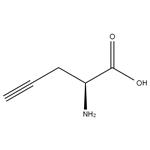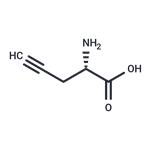ChEBI: L-propargylglycine is a non-proteinogenic L-alpha-amino acid that is L-alanine in which one of the methyl hydrogens has been replaced by an ethynyl group. It causes the irreversible inactivation of gamma-cystathionase (also known as cystathionine gamma-lyase) and is used as an affinity labeling reagent for gamma-cystathionase and other enzymes. It has a role as an EC 1.4.3.2 (L-amino-acid oxidase) inhibitor, an EC 2.6.1.2 (alanine transaminase) inhibitor and an EC 2.5.1.48 (cystathionine gamma-synthase) inhibitor. It is a non-proteinogenic L-alpha-amino acid and a terminal acetylenic compound. It is a tautomer of a L-propargylglycine zwitterion.
L-C-Propargylglycine, a specific inhibitor of H(2)S synthase of cystathionine-γ-lyase (CSE), may be used to study the role of H2S in regulation of biological processes.', 'L-propargylglycine (PAG), an inhibitor of cystathionine γ-lyase (CSE), is useful in studies of hydrogen sulphide synthesis and bioactivity.
This alkynyl amino acid and mechanism-based inhibitor (FW = 113.11 g/mol; CAS 23235-01-0), also known as (S)-2-amino-4-pentynoic acid, irreversibly inactivates γ-cystathionase (an enzyme that also catalyzes the synthesis of the metabolic signaling gas, H2S, See also Hydrogen Sulfide), acting as a Michael addition type suicide inhibitor of cystathionine γ-lyase, cystathionine γ-synthase, alanine aminotransferase, and methionine γ-lyase. Propargylglycine inactivates γ-cystathionase with pseudo-first-order kinetics and incorporation of 1 mol inhibitor per 80 kDa enzyme. When studied in vivo, inactivation of cystathionine γ-lyase in rat kidney was less than that in the liver, owing to the presence of a higher cysteine concentration in kidney. L-Propargylglycine was found to inactivate pig heart L-alanine transaminase (EC 2.6.1.2) at 37o C with a Ki = 3.9 mM, an observed maximal first order rate constant, kinact = 0.26 min–1, a minimal stoichiometric ratio necessary for inactivation of 2.7 L-propargylglycine molecules/enzyme subunit, with 2.2 molecules/subunit undergoing transamination before inactivation ensues. Experimental cystathioninuria, induced in rats by administration of D,L-propargylglycine, results in the formation of the cystathionine metabolites, cystathionine ketimine and perhydro-1,4-thiazepine-3,5-dicarboxylic acid, in various regions of the brain. L-Propargylglycine irreversibly inactivates proline dehydrogenase, which catalyzes the first step of proline catabolism, oxidizing proline to pyrroline-5-carboxylate. The 1.9-? resolution structure of the inactivated Thermus thermophilus enzyme shows that N5 of the flavin cofactor is covalently connected to the e-amino group of Lys-99 via a three-carbon linkage, consistent with the mass spectral analysis of the inactivated enzyme. The isoalloxazine ring has a butterfly angle of 25o, suggesting the cofactor is reduced. Two mechanisms, both involving oxidation to N-propargyliminoglycine, can account for these properties. L-Propargylglycine irreversibly inhibits L-amino acid oxidase from the venom of Crotalus adamanteus (Eastern diamondback rattlesnake) and Crotalus atrox (Western diamondback rattlesnake) in a dose- and timedependent manner that was blocked by the substrate L-phenylalanine. Other targets include methionineγ-lyase and UDP-Nacetylmuramate: L-alanine ligase, or L-alanine-adding enzyme, or UDP-Nacetylmuramoyl- L-alanine synthetase.
The acid crystallises readily when ~4g in 50mL H2O are treated with absolute EtOH at 4o/3hours, and is collected, washed with cold absolute EtOH and Et2O and dried in a vacuum. Also, it recrystallises from aqueous Me2CO, RF on SiO2 TLC plates with n-BuOH/H2O/AcOH (4:1:1) is 0.26. The racemate has m 238-240o. [Leukart et al. Helv Chim Acta 59 2181 1976, Eberle & Zeller Helv Chim Acta 68 1880 1985, Jansen et al. Recl Trav Chim Pays-Bas 88 819 1969.] It is a suicide inhibitor of �-cystathionase and other enzymes [Washtier & Abeles Biochemistry 16 2485 1977, Shinozuka et al. Eur J Biochem 124 377 1982].


